The ASRock X99E-ITX/ac Review: Up to 36 Threads in Mini-ITX
by Ian Cutress on June 24, 2015 8:00 AM ESTCPU Performance
Readers of our motherboard review section will have noted the trend in modern motherboards to implement a form of MultiCore Enhancement / Acceleration / Turbo (read our report here) on their motherboards. This does several things, including better benchmark results at stock settings (not entirely needed if overclocking is an end-user goal) at the expense of heat and temperature. It also gives in essence an automatic overclock which may be against what the user wants. Our testing methodology is ‘out-of-the-box’, with the latest public BIOS installed and XMP enabled, and thus subject to the whims of this feature. It is ultimately up to the motherboard manufacturer to take this risk – and manufacturers taking risks in the setup is something they do on every product (think C-state settings, USB priority, DPC Latency / monitoring priority, memory subtimings at JEDEC). Processor speed change is part of that risk, and ultimately if no overclocking is planned, some motherboards will affect how fast that shiny new processor goes and can be an important factor in the system build.
For reference, the X99E-ITX/ac has Multicore Turbo disabled by default in BIOS P1.20. The important element to note here is if dual channel memory has an effect in performance.
Point Calculations – 3D Movement Algorithm Test: link
3DPM is a self-penned benchmark, taking basic 3D movement algorithms used in Brownian Motion simulations and testing them for speed. High floating point performance, MHz and IPC wins in the single thread version, whereas the multithread version has to handle the threads and loves more cores. For a brief explanation of the platform agnostic coding behind this benchmark, see my forum post here.

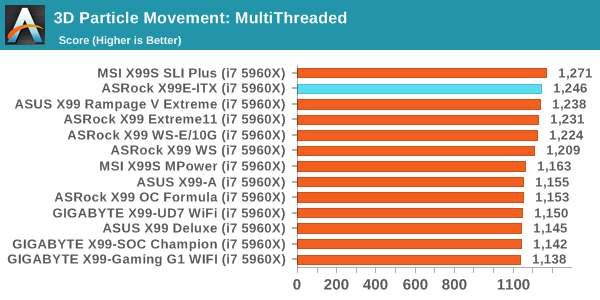
3DPM is not DRAM dependent, so dual channel memory has no issue here.
Compression – WinRAR 5.0.1: link
Our WinRAR test from 2013 is updated to the latest version of WinRAR at the start of 2014. We compress a set of 2867 files across 320 folders totaling 1.52 GB in size – 95% of these files are small typical website files, and the rest (90% of the size) are small 30 second 720p videos.
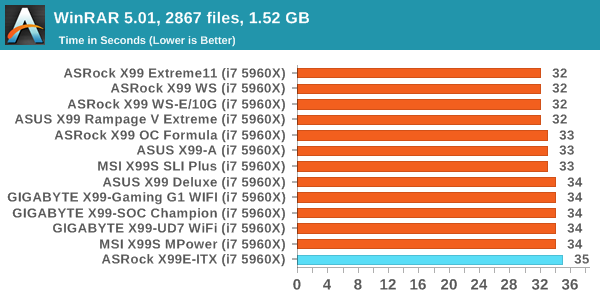
WinRAR is typically a benchmark that tackles DRAM, and we see that the dual channel orientation has a small detriment here.
Image Manipulation – FastStone Image Viewer 4.9: link
Similarly to WinRAR, the FastStone test us updated for 2014 to the latest version. FastStone is the program I use to perform quick or bulk actions on images, such as resizing, adjusting for color and cropping. In our test we take a series of 170 images in various sizes and formats and convert them all into 640x480 .gif files, maintaining the aspect ratio. FastStone does not use multithreading for this test, and thus single threaded performance is often the winner.
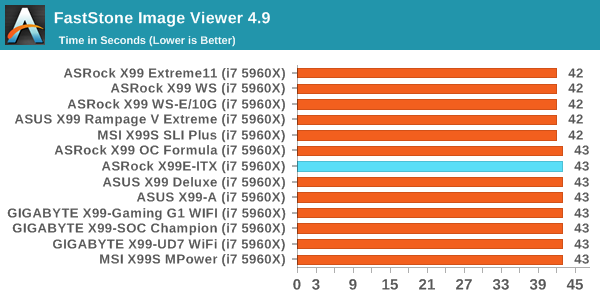
FastStone is a CPU benchmark, so no difference here.
Video Conversion – Handbrake v0.9.9: link
Handbrake is a media conversion tool that was initially designed to help DVD ISOs and Video CDs into more common video formats. The principle today is still the same, primarily as an output for H.264 + AAC/MP3 audio within an MKV container. In our test we use the same videos as in the Xilisoft test, and results are given in frames per second.
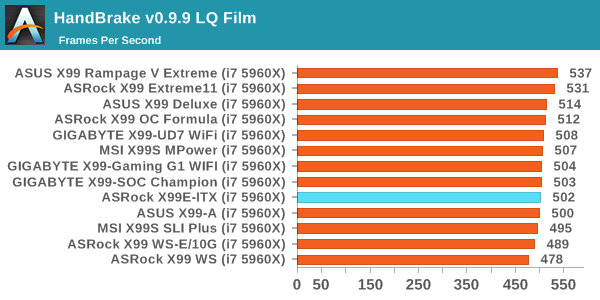
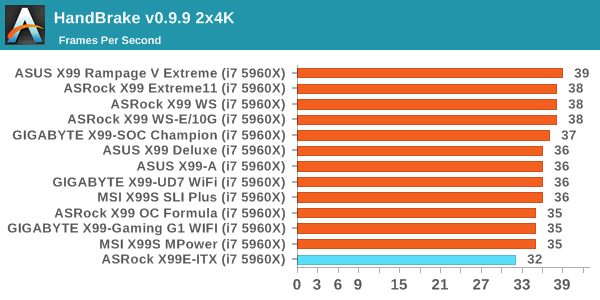
One would normally point at video conversion as requiring DRAM accesses, but we see a difference here between low quality conversion and high quality conversion. Using the larger frames we see that dual channel memory causes a ~10% drop in performance compared to other non-MCE enabled motherboards.
Rendering – PovRay 3.7: link
The Persistence of Vision RayTracer, or PovRay, is a freeware package for as the name suggests, ray tracing. It is a pure renderer, rather than modeling software, but the latest beta version contains a handy benchmark for stressing all processing threads on a platform. We have been using this test in motherboard reviews to test memory stability at various CPU speeds to good effect – if it passes the test, the IMC in the CPU is stable for a given CPU speed. As a CPU test, it runs for approximately 2-3 minutes on high end platforms.
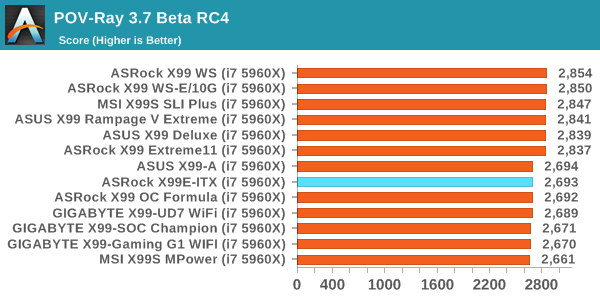
No changes for POV-Ray in dual channel.
Synthetic – 7-Zip 9.2: link
As an open source compression tool, 7-Zip is a popular tool for making sets of files easier to handle and transfer. The software offers up its own benchmark, to which we report the result.
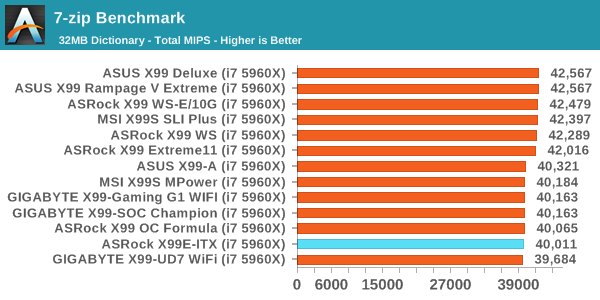
Similarly no difference in 7-zip.










56 Comments
View All Comments
mobutu - Wednesday, June 24, 2015 - link
In the Linus video that you linked in the article, they test is with 2*16 = 32GB RAM:https://youtu.be/MjDJNwAANwA?t=7m5s
Samus - Wednesday, June 24, 2015 - link
Ian, even if we are the only two customers asrock has for this board...I'm ok with that because I'm glad somebody actually took the time to properly engineer and manufacture the high end Intel platform in ITX. Just amazing what has been accomplished here.piasabird - Wednesday, June 24, 2015 - link
It kind of defeats the purpose to use a powerful CPU in a MINI-ITX system. X99 should be Quad Lane DDR4 Memory access. The more powerful the Processor the more it can benefit from lots of the fastest RAM. A MATX setup might make more sense. You are also forced to use a video card due to no onboard IGP for that socket.Samus - Thursday, June 25, 2015 - link
If you didn't want to use the PCIe lane for a video card, there is a BCM. You can boot and run the entire system without a videocard. The BCM can even do 1920x1080!You could easily add an 8" 8-port Areca SAS RAID card to that 16x slot, although I don't know why you'd want ITX (or this platform at all...) if your plan was to make a file server.
TomWomack - Friday, June 26, 2015 - link
Did you read the article? Its entire purpose was to quantify the cost of switching to dual-lane DDR4, and it quantified it as 'not very much under most circumstances'.glugglug - Wednesday, June 24, 2015 - link
They should have waited just a little longer, and included HD6200 graphics. A small server like this with QuickSync and no need for a video card would be something.Samus - Thursday, June 25, 2015 - link
You don't need a video card or onboard video. It has a management chip (BCM) that can output video via CAT5e. You can use a media converter or just use remote management.Gigaplex - Thursday, June 25, 2015 - link
Who would include the HD6200? That's part of the CPU, not the motherboard.fallaha56 - Wednesday, June 24, 2015 - link
stick a Fury Nano in this and let's see some action ;-)just4U - Wednesday, June 24, 2015 - link
I am interested in these smaller boards.. sure the Quad channel memory would be nice but whatever.. no biggie.. No crossfire/SLI isn't a issue for me either since I only ever use one Video Card (usually mid-high end)The only complaint.. I've yet to find a mini-itx case I want to build a system around. So I keep going the Matx route instead.